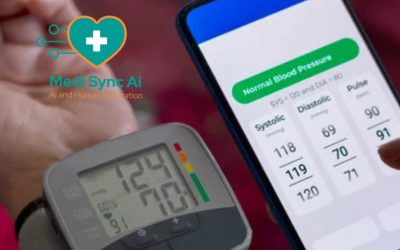Introduction
The healthcare landscape is rapidly evolving, and digital innovations like Remote Patient Monitoring (RPM) have become essential tools in improving patient outcomes. RPM enables healthcare providers to monitor patients outside traditional clinical settings, leveraging advanced technologies to track vital signs, manage chronic conditions, and provide timely interventions.
The Centers for Medicare & Medicaid Services (CMS) recognizes the value of RPM and has integrated it into its programs to enhance patient care while reducing healthcare costs. However, meeting CMS guidelines for remote patient monitoring can be challenging, as it requires adherence to specific eligibility criteria. This comprehensive guide will outline these criteria, clarify common misconceptions, and explain how Medi Sync AI can simplify compliance, empowering healthcare providers to unlock the full potential of RPM.
Understanding CMS Programs and Remote Patient Monitoring
CMS and Its Role in Remote Patient Monitoring
The CMS oversees federal healthcare programs, including Medicare and Medicaid, aiming to improve access to quality care while controlling expenditures. Remote Patient Monitoring is a key component of CMS’s strategy, as it facilitates proactive care management for patients with chronic or high-risk conditions.
Through its reimbursement programs, CMS encourages providers to adopt RPM by offering financial incentives. However, to qualify for these benefits, providers must follow specific guidelines and eligibility requirements. These rules ensure that RPM services maintain high standards, prioritize patient outcomes, and safeguard sensitive health information.
What Makes RPM Unique in CMS Programs?
Unlike traditional telehealth, which focuses on synchronous communication between patients and providers, RPM emphasizes continuous data collection and analysis. CMS defines RPM as the use of technology to remotely collect and interpret patient health data. This data, such as blood pressure or glucose levels, is used to guide clinical decision-making, reduce hospital readmissions, and promote preventive care.
Eligibility Criteria for Remote Patient Monitoring in CMS Programs
Meeting CMS eligibility criteria is critical for healthcare providers seeking reimbursement for RPM services. The criteria cover multiple aspects, including patient demographics, provider qualifications, technology standards, and documentation requirements.
Patient Eligibility
To qualify for RPM under CMS programs, patients must meet certain conditions:
- Chronic or High-Risk Conditions: CMS prioritizes patients with chronic diseases like hypertension, diabetes, or COPD, as well as those at high risk for hospitalization.
- Medicare Enrollment: Patients must be enrolled in Medicare Part B or another CMS-approved program.
- Consent: Patients must provide written or verbal consent to participate in RPM, documented in their medical records.
- Clinical Justification: Providers must demonstrate that RPM is medically necessary to manage the patient’s condition.
Provider Eligibility
CMS sets strict guidelines on who can offer RPM services:
- Qualified Healthcare Providers: Physicians, nurse practitioners, physician assistants, and clinical staff under the supervision of a qualified provider can deliver RPM services.
- Enrollment in Medicare: Providers must be enrolled in Medicare or another CMS-approved program.
- Billing Requirements: Providers must use specific billing codes, such as CPT codes 99453, 99454, 99457, and 99458, to receive reimbursement.
Device and Technology Requirements
The technology used for RPM must meet CMS standards:
- FDA Approval: Devices must be FDA-approved and capable of transmitting patient health data electronically.
- Continuous Monitoring: The device should enable daily or near-daily data collection.
- Data Security: All devices must comply with HIPAA regulations to ensure the confidentiality and integrity of patient data.
Documentation and Reporting Standards
Proper documentation is essential for CMS compliance:
- Initial Setup Documentation: Records must include details about the initial setup and patient education.
- Data Transmission Logs: Providers must maintain logs of the data collected and transmitted from the patient’s device.
- Clinical Notes: Regular documentation of how RPM data is used to inform care plans and interventions is required.
- Patient Interaction Records: CMS requires evidence of at least one live, interactive communication per month between the provider and patient.
Benefits of Meeting RPM Eligibility Criteria
Meeting CMS eligibility criteria for RPM has far-reaching benefits:
- Enhanced Patient Outcomes: RPM supports early detection of health issues, leading to timely interventions and better management of chronic conditions.
- Financial Incentives: Providers gain access to CMS reimbursement, reducing the financial burden of implementing RPM.
- Operational Efficiency: RPM streamlines workflows by automating data collection and analysis, enabling providers to focus on patient care.
- Improved Patient Engagement: By involving patients in their health monitoring, RPM fosters greater engagement and adherence to treatment plans.
Common Challenges in Meeting RPM Eligibility Criteria
While the benefits of RPM are substantial, navigating CMS guidelines can be complex:
- Understanding Regulations: The intricate details of CMS guidelines can be overwhelming for providers new to RPM.
- Technology Integration: Ensuring that devices meet CMS standards and integrate seamlessly with electronic health record (EHR) systems can be challenging.
- Patient Enrollment: Obtaining patient consent and ensuring they understand the benefits of RPM requires time and effort.
- Compliance Management: Providers must maintain meticulous records to demonstrate compliance, which can strain administrative resources.
How Medi Sync AI Simplifies RPM for CMS Compliance
Medi Sync AI is designed to help healthcare providers overcome these challenges, making RPM implementation seamless and compliant with CMS guidelines. Here’s how:
- Automated Documentation: Our platform automates the documentation process, ensuring accurate and comprehensive records that meet CMS requirements.
- Device Compatibility: Medi Sync AI integrates with FDA-approved devices, providing secure and reliable data transmission.
- Patient Engagement Tools: Our user-friendly interface educates patients about RPM and simplifies consent collection, enhancing enrollment rates.
- Compliance Monitoring: Real-time compliance alerts help providers stay on track with CMS standards, reducing the risk of denied claims.
Final Thoughts: Empowering RPM with Medi Sync AI
Remote Patient Monitoring is transforming healthcare by enabling proactive and personalized care. However, meeting CMS eligibility criteria is essential to unlock its full potential. Medi Sync AI simplifies this process, providing the tools and support healthcare providers need to implement RPM confidently and effectively.
If you’re ready to enhance patient outcomes, streamline operations, and maximize CMS reimbursements, Medi Sync AI is your trusted partner. Contact us today to learn how our solutions can empower your RPM journey and elevate your practice.





